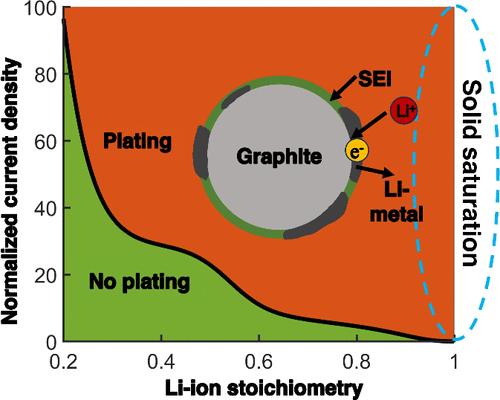快充锂离子电池镀锂的开始
IF 18.2
1区 材料科学
Q1 CHEMISTRY, PHYSICAL
引用次数: 0
摘要
锂(Li)电镀是限制快速充电锂离子电池应用的一个主要挑战,但其发生机制仍然难以捉摸。我们提出了一个在涂有固体电解质相间层(SEI)的石墨颗粒上电镀锂的模型,以阐明离子传输、反应动力学和相变的耦合效应。我们推导出了一个分析表达式,该表达式将锂镀层开始时间与操作条件和材料特性联系起来,并引入了锂镀层图。我们的框架捕捉到了驱动锂电镀和阳极电位下降的复杂机制,超越了现有的表面离子饱和和电解质耗竭的限制情况。通过加深对关键参数之间相互关系的理解,我们的研究结果为调整充电协议、设计电池组件和人工 SEI 层工程提供了宝贵的指导。实施这些策略有助于减轻镀锂现象,确保锂离子电池在快速充电期间的安全性和性能。本文章由计算机程序翻译,如有差异,请以英文原文为准。

Onset of Lithium Plating in Fast-Charging Li-Ion Batteries
Lithium (Li) plating is a major challenge limiting the adoption of fast-charging Li-ion batteries, yet its onset mechanisms remain elusive. We present a model of Li plating on a graphite particle coated with a solid electrolyte interphase (SEI) layer to elucidate the coupled effects of ion transport, reaction kinetics, and phase transformation. We derive an analytical expression that relates Li-plating onset time to operating conditions and material properties and introduce a Li-plating diagram. Our framework captures the intricate mechanisms driving Li plating and anode potential drops, extending beyond existing limiting cases of surface ion saturation and electrolyte depletion. By providing an improved understanding of the interrelationships among key parameters, our findings provide valuable guidance for adjusting charging protocols, designing cell components, and engineering artificial SEI layers. Implementing these strategies can help mitigate Li plating and ensure Li-ion battery safety and performance during fast charging.
求助全文
通过发布文献求助,成功后即可免费获取论文全文。
去求助
来源期刊

ACS Energy Letters
Energy-Renewable Energy, Sustainability and the Environment
CiteScore
31.20
自引率
5.00%
发文量
469
审稿时长
1 months
期刊介绍:
ACS Energy Letters is a monthly journal that publishes papers reporting new scientific advances in energy research. The journal focuses on topics that are of interest to scientists working in the fundamental and applied sciences. Rapid publication is a central criterion for acceptance, and the journal is known for its quick publication times, with an average of 4-6 weeks from submission to web publication in As Soon As Publishable format.
ACS Energy Letters is ranked as the number one journal in the Web of Science Electrochemistry category. It also ranks within the top 10 journals for Physical Chemistry, Energy & Fuels, and Nanoscience & Nanotechnology.
The journal offers several types of articles, including Letters, Energy Express, Perspectives, Reviews, Editorials, Viewpoints and Energy Focus. Additionally, authors have the option to submit videos that summarize or support the information presented in a Perspective or Review article, which can be highlighted on the journal's website. ACS Energy Letters is abstracted and indexed in Chemical Abstracts Service/SciFinder, EBSCO-summon, PubMed, Web of Science, Scopus and Portico.
 求助内容:
求助内容: 应助结果提醒方式:
应助结果提醒方式:


